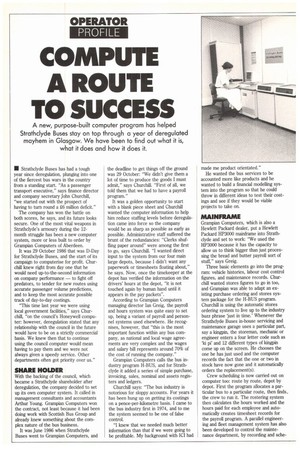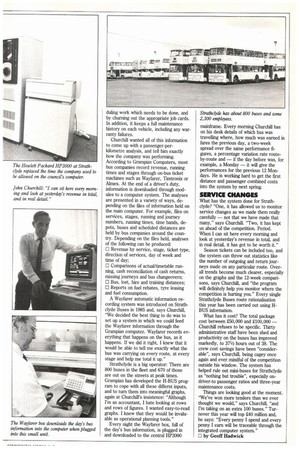COMPUTE A ROUTE TO SUCCESS
Page 42

Page 43

If you've noticed an error in this article please click here to report it so we can fix it.
A new, purpose-built computer program has helped Strathclyde Buses stay on top through a year of deregulated mayhem in Glasgow. We have been to find out what it is, what it does and how it does it.
• Strathclyde Buses has had a tough year since deregulation, plunging into one of the fiercest bus wars in the country from a standing start. "As a passenger transport executive," says finance director and company secretary John Churchill, "we started out with the prospect of having to turn round a £6 million deficit."
The company has won the battle on both scores, he says, and its future looks secure. One of the most vital weapons in Strathclyde's armoury during the 12month struggle has been a new computer system, more or less built to order by Grampian Computers of Aberdeen.
It was 29 October 1986 that was D-Day for Strathclyde Buses, and the start of its campaign to computerise for profit. Churchill knew right from day one that he would need up-to-the-second information on company performance — to fight off predators, to tender for new routes using accurate passenger volume predictions, and to keep the most accurate possible track of day-to-day costings.
"This time last year we were using local government facilities," says Churchill, "on the council's Honeywell computer: however, deregulation stated that any relationship with the council in the future would have to be on a strictly commercial basis. We knew then that to continue using the council computer would mean having to pay them and we were not always given a speedy service. Other departments often got priority over us."
SHARE HOLDER
With the backing of the council, which became a Strathclyde shareholder after deregulation, the company decided to set up its own computer system. It called in management consultants and accountants Arthur Young. Grampian Computers won the contract, not least because it had been doing work with Scottish Bus Group and already knew something about the complex nature of the bus business.
It was June 1986 when Strathclyde Buses went to Grampian Computers, and the deadline to get things off the ground was 29 October: "We didn't give them a lot of time to produce the goods I must admit," says Churchill. "First of all, we told them that we had to have a payroll program."
It was a golden opportunity to start with a blank piece sheet and Churchill wanted the computer information to help him reduce staffing levels before deregulation came into force so the company would be as sharp as possible as early as possible. Administrative staff suffered the brunt of the redundancies: "Clerks shuffling paper around" were among the first to go, says Churchill. "I wanted direct input to the system from our four main large depots, because I didn't want any paperwork or tirnesheets floating about," he says. Now, once the timekeeper at the depot has verified the information on the drivers' hours at the depot, "it is not touched again by human hand until it appears in the pay packets".
According to Grampian Computers managing director Ian Greig, the payroll and hours system was quite easy to set up, being a variant of payroll and personnel systems used elsewhere. He recognises, however, that "this is the most important function within any bus company, as national and local wage agreements are very complex and the wages and salary bill represents around 70% of the cost of running the company."
Grampian Computers calls the bus industry program H-BUS, and for Strathclyde it added a series of simple purchase, invoicing, sales, nominal and assets registers and ledgers.
Churchill says: "The bus industry is notorious for sloppy accounts. For years it has been hung up on getting its castings on a pence-per-kilometre basis. I came to the bus industry first in 1974, and to me the system seemed to be one of false control.
"I knew that we needed much better information than that if we were going to be profitable. My background with ICI had made me product orientated."
He wanted the bus services to be accounted more like products and he wanted to build a financial modelling system into the program so that he could throw in different ideas to test their costings and see if they would be viable projects to take on.
MAINFRAME
Grampian Computers, which is also a Hewlett Packard dealer, put a Hewlett Packard HP3000 mainframe into Strathclyde and set to work: "We used the HP3000 because it has the capacity to allow us to think bigger than just processing the bread and butter payroll sort of stuff," says Greig.
Three basic elements go into the program: vehicle histories, labour cost control figures, and maintenance records. Churchill wanted stores figures to go in too, and Grampian was able to adapt an existing purchase ordering and stores system package for the H-BUS program. Churchill is using the automatic stores ordering system to live up to the industry buzz phrase 'just in time.' Whenever the Strathclyde Buses in-house servicing and maintenance garage uses a particular part, say a kingpin, the storeman, mechanic or engineer enters a four letter code such as pi' and 12 different types of kingpin come up on the screen. He chooses the one he has just used and the computer records the fact that the one or two in stock have now gone and it automatically orders the replacement(s).
Crew scheduling is now carried out on computer too: route by route, depot by depot. First the program allocates a particular bus to a particular route, then finds. the crew to run it. The rostering system then calculates the hours worked and the hours paid for each employee and automatically creates timesheet records for the payroll program. A parallel engineering and fleet management system has also been developed to control the maintenance department, by recording and sche duling work which needs to be done, and by churning out the appropriate job cards. In addition, it keeps a full maintenance history on each vehicle, including any warranty failures.
Churchill wanted all of this information to come up with a passenger-perkilometre analysis, and tell him exactly how the company was performing. According to Grampian Computers, most bus companies record revenue, running times and stages through on-bus ticket machines such as Wayfarer, Timtronix or Almex. At the end of a driver's duty, information is downloaded through modules to a computer system. The analyses are presented in a variety of ways, depending on the files of information held on the main computer. For example, files on services, stages, running and journey numbers, running times, time bands, depots, buses and scheduled distances are held by bus companies around the country. Depending on the files held, analyses of the following can be produced: O Revenue by service, stage, ticket type, direction of services, day of week and time of day; O Comparisons of actual/timetable running, cash reconciliation of cash returns, missing journeys and bus changeovers; 0 Bus, lost, hire and training distances; O Reports on fuel rebates, tyre leasing and fuel consumption.
A Wayfarer automatic information recording system was introduced on Strathclyde Buses in 1985 and, says Churchill, "We decided the best thing to do was to set up a system in which we could feed the Wayfarer information through the Grampian computer. Wayfarer records everything that happens on the bus, as it happens. If we did it right, I knew that it would be able to tell me exactly what the bus was carrying on every route, at every stage and help me total it up."
Strathclyde is a big operator: There are 800 buses in the fleet and 670 of those are out on the streets at peak times. Grampian has developed the H-BUS program to cope with all these diffemt inputs, and to turn them into meaningful graphs, again at Churchill's insistence: "Although I'm an accountant, I hate looking at rows and rows of figures. I wanted easy-to-read graphs. I knew that they would be invaluable as operational planning tools."
Every night the Wayfarer box, full of the day's bus information, is plugged in and downloaded to the central HP3000 mainframe. Every morning Churchill has on his desk details of which bus was travelling where, how much was earned in fares the previous day, a two-week spread over the same performance figures, a percentage variation rate routeby-route and — if the day before was, for example, a Monday — it will give the performances for the previous 12 Mondays. He is working hard to get the first distance and passenger combined costs into the system by next spring.
SERVICE CHANGES
What has the system done for Strathclyde? "One, it has allowed us to monitor service changes as we made them really carefully — not that we have made that many," says Churchill. "Two, it has kept us ahead of the competition. Period. When I can sit here every morning and look at yesterday's revenue in total, and in real detail, it has got to be worth it."
Season tickets can be included too, and the system can throw out statistics like the number of outgoing and return journeys made on any particular route. Overall trends become much clearer, especially on the graphs and the 12-week comparisons, says Churchill, and "the program will definitely help you monitor where the competition is hurting you." Every single Strathclyde Buses route rationalisation this year has been carried out using HBUS information.
What has it cost? The total package cost between E50,000 and 2100,000 — Churchill refuses to be specific. Thirty administrative staff have been shed and productivity on the buses has improved markedly, to 371/2 hours out of 38. The crew cost savings have been "considerable", says Churchill, being cagey once again and ever mindful of the competition outside his window. The system has helped rule out mini-buses for Strathclyde as "nothing but trouble", especially ondriver-to passenger ratios and three-year maintenance costs.
Things are looking good at the moment. "We've won more tenders than we ever thought we would," says Churchill, "and I'm taking on an extra 100 buses." Turnover this year will top ,40 million and, he says: "Every penny I spend and every penny I earn will be traceable through the integrated computer system."
0 by Geoff Hadwick




































































































































